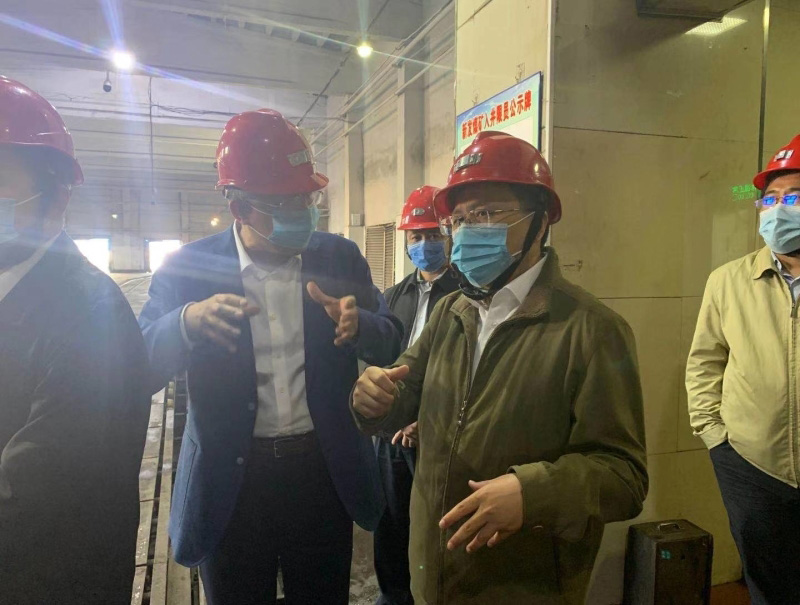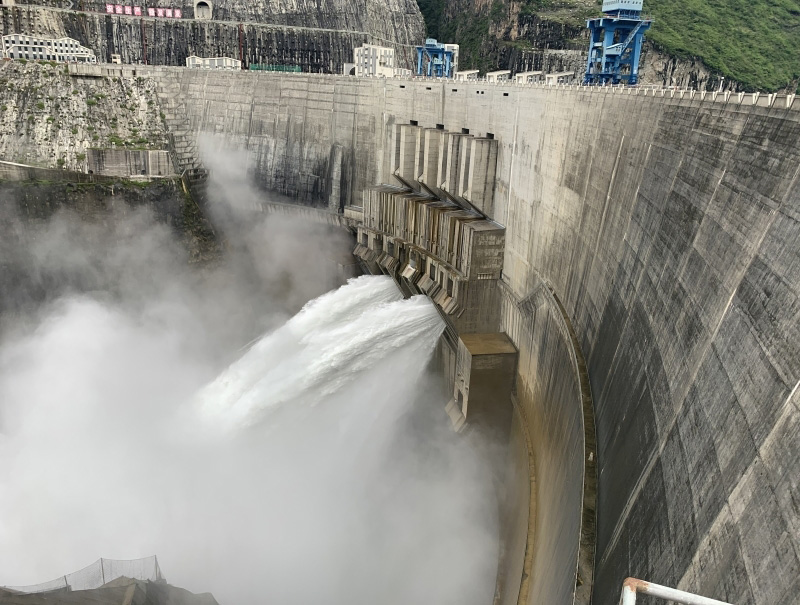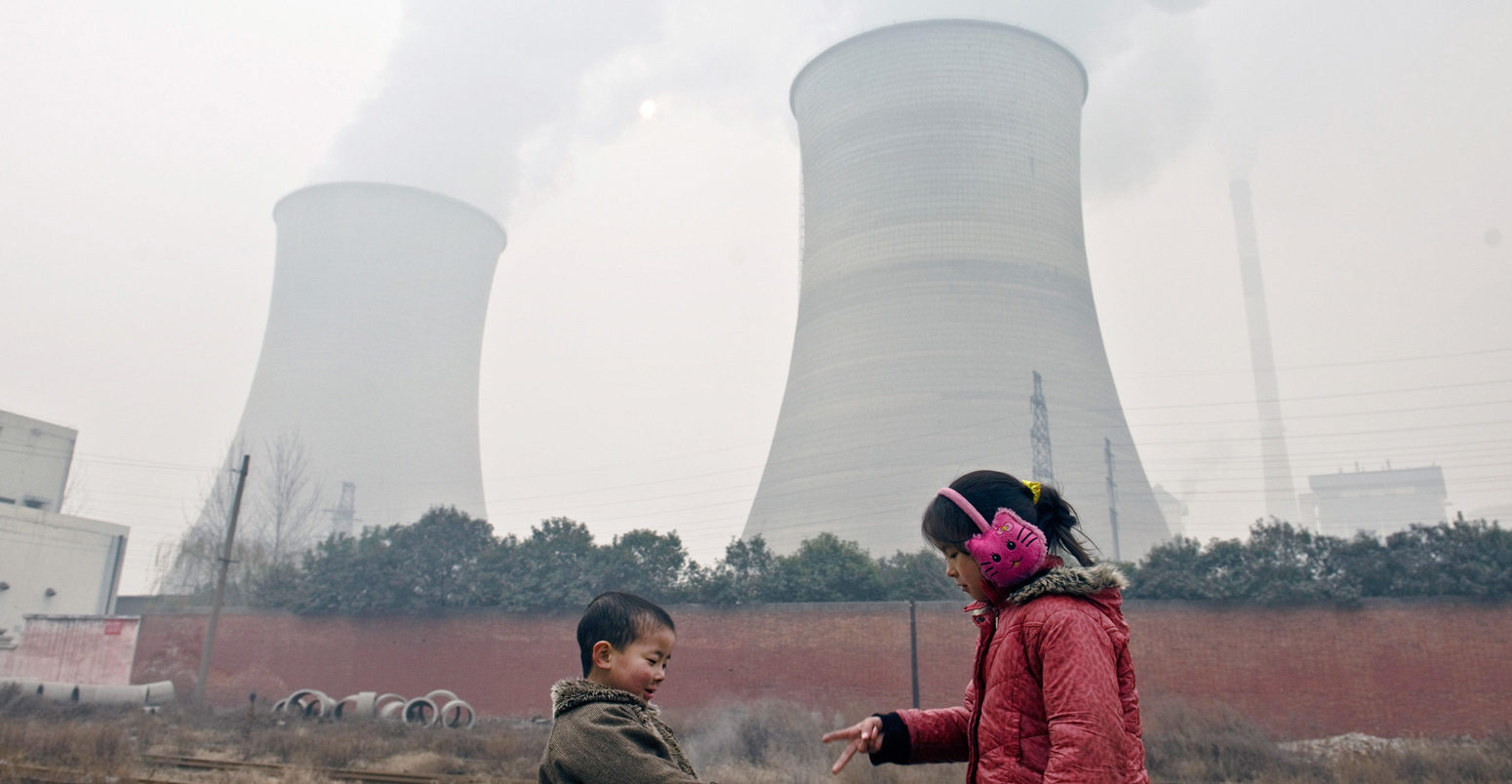
Q&A: Could an environmental inspector’s criticisms accelerate China’s climate policies?
Multiple Authors
02.05.21Multiple Authors
05.02.2021 | 1:54pmLast week, in a move that has shocked observers, China’s Central Environmental Inspection Team (CEIT) openly criticised the central government’s National Energy Administration (NEA) for failing to limit the country’s expansion of coal power plants.
CEIT’s inspection report also scolded the NEA for “falling behind” on promoting the development of low-carbon energy.
The tone of the criticism has been described as unprecedented. Never before has a high-level central government agency been inspected and openly criticised for multiple “failures” related to energy development.
In this in-depth Q&A, Carbon Brief explains what this rare and potentially pivotal move might mean for China’s climate and energy policies.
- What actually happened last week?
- What is the ‘CEIT’?
- Why is the CEIT’s inspection of the NEA so significant?
- How does the CEIT work?
- What does the CEIT’s accusation of a ‘deteriorated political ecology’ mean?
- What other accusations have been made against the NEA?
- What comes next now that the CEIT’s criticisms have been made public?
- Will any ‘rectifications’ made by the NEA impact China’s climate and energy policies?
- What has the wider reaction been?
What actually happened last week?
Last week, China’s NEA came under heavy criticism. The CEIT released an inspection report on the NEA, harshly criticising it for failing to implement environmental protections properly.

The CEIT is a new, but powerful institution formed by China’s top leaders to ensure the implementation of such protections. It is co-led by the Central Committee of the Communist Party of China (CCCPC) and the State Council, which are, respectively, the highest authorities of the Communist Party of China (CPC) and the central government.
Over the past four months, the CEIT has been inspecting the NEA and it provided its feedback to the NEA on 29 January. On the same day, the Ministry of Environment and Ecology (MEE), whose officials are part of the CEIT, and the NEA, the subject of the inspection, both posted the full report on their official websites.
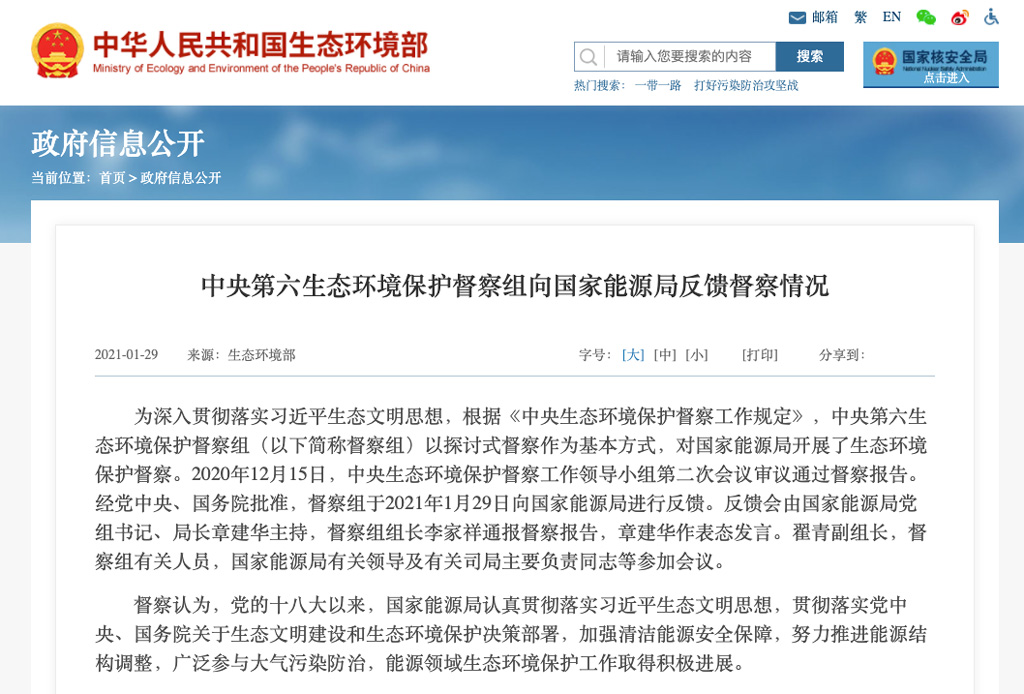
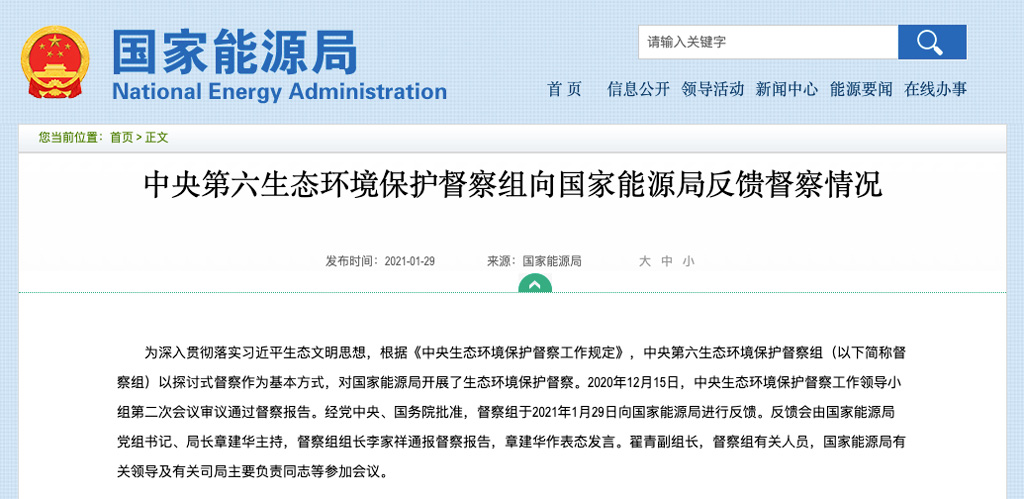
In the CEIT’s report, the NEA was criticised for its “deteriorated political ecology” and for “failing to strictly control the excess coal power capacity in key areas of air pollution, prevention and control”. It also said the NEA was “a major cause of the long-term extensive development of China’s energy sector” – by which it predominantly implies the coal power sector.
The 2,900-word report includes unusually trenchant and critical vocabulary. For example, the report says the NEA made “inadequate efforts”, “violated relevant regulations”, has “not being prudent” and has “misconceptions” about the “synergies” between the environment and energy development.
The NEA was asked by the CEIT to speed up the “adjustment” of energy infrastructure to develop renewable energy “with high quality”, as well as to “optimise” heavy industry and coal power plants. The NEA is now required to report back to the CCCPC and State Council with its “rectification of the situation” within 30 working days.
This is not the first time that the CEIT has identified and exposed energy-related environmental issues in its, to date, six rounds of nationwide inspections. The latest report highlights that, to some extent, the NEA showed “indifference” to the issues that the CEIT had previously revealed about China’s energy sector.
Following this release, the CEIT published another inspection report on the National Forestry and Grassland Administration (NFGA), managed by the Ministry of Natural Resources, on 1 February. The two administrations are by far the highest agencies of the central government that have been investigated by the CEIT at an institutional level.
What is the ‘CEIT’?
China’s leader Xi Jinping created the Central Environmental Inspection Team (CEIT) himself in 2015. At a CEIT meeting in September 2020, participants revealed that “Xi Jinping personally initiated this major reform initiative”.
The CEIT was established to expose and disrupt the protection of high-polluting and energy-consuming industries by various powerful departments and regions.
“The biggest problem with environmental enforcement in the past was that it was difficult to restrain local party committees and governments,” said Qin Tianbao, director of the Research Institute of Environmental Law at Wuhan University, in a 2016 interview with Caixin, a Chinese publication which covers, among other topics, energy and environmental issues.
Qin added that, with its significantly increased authority and “deterrent effect”, the CEIT could help to end the local protectionism of environmental oversight.
The new inspection system’s first target in 2015 was Hebei, a populated province near Beijing known for its heavy industry and agriculture. Hebei’s pollution was directly contributing to Beijing’s deteriorating air quality.
Four years later, in 2019, the CEIT system was upgraded from an “inspection group” of environmental protection led by the State Council to one led by the CCCPC. Inspection targets were also expanded to include relevant departments of the State Council and state-owned enterprises (SEOs), with an instruction that the inspections operate on a five-year cycle.
The CEIT now reports to Han Zheng. Han is one of the seven members of the Standing Committee of the Political Bureau of CPC (Politburo), the highest authority in China, and the State Council’s vice-premier. He is Xi’s right-hand man in energy, finance and environmental protection.
In the most recent inspection round, the CEIT’s leadership team consisted of high-profile officials from the CCCPC and the Politburo, as well as MEE vice ministers.
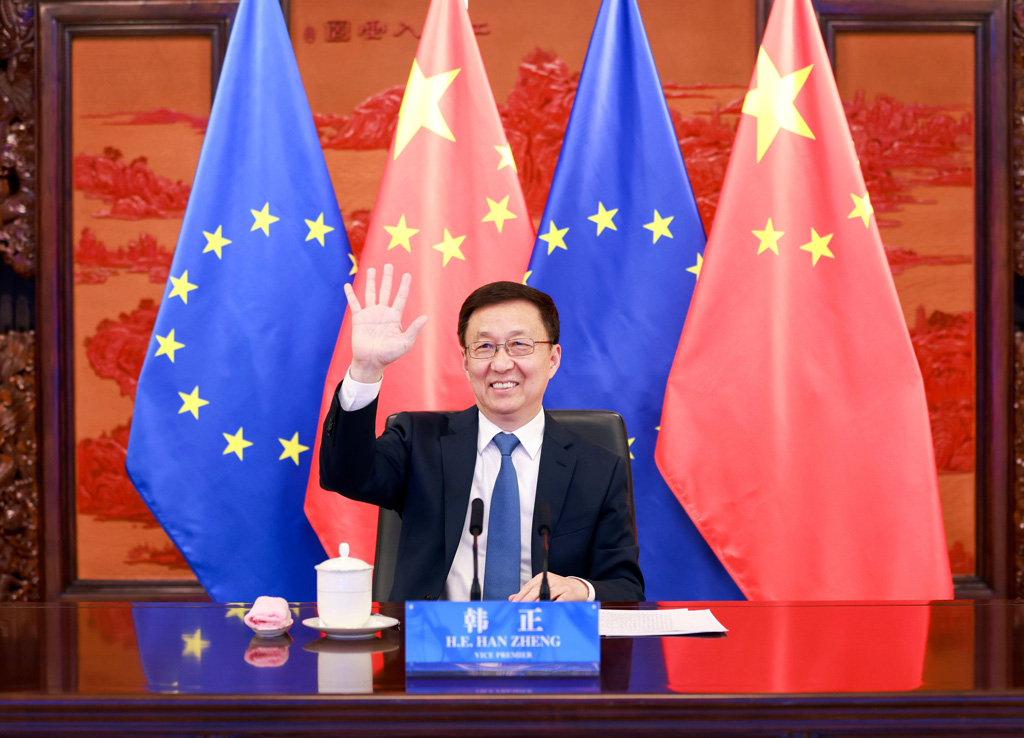
Ma Jun, director of the Institute of Public & Environmental Affairs (IPE), a leading environmental NGO based in Beijing, thinks the CEIT is a product of the unique feature of the Chinese governance system, in which a “strong administrative force” can be dedicated to solving environmental challenges.
But he also emphasises the role of the CCCPC in the CEIT, the participation of which distances the new mechanism with the previous Environmental Inspection Team, which was solely organised by the Ministry of Environment and Ecology (MEE). Prior to the establishment of the CEIT, MEE was criticised for “lacking teeth” regarding the enforcement of environmental laws and regulations, although it had a record of dispatching officials to investigate major environmental incidents exposed by civil society groups.
Chang Jiwen, vice-director-general of the Research Institute for Resources and Environment Policies at Development Research Center of the State Council (DRC), a government thinktank, said in an 2018 interview with China Online, a state-affiliated media supervised directly by the State Council:
“The CEIT…has launched a new landscape for environmental protection, as it now pursues both the [local] government and the local CPC committees for accountability…It is very difficult to do a good job in environmental protection without putting pressure on the local CPC committees and just letting the [local] government do it. So [now], through the CEIT, the problem of ‘attitude’ has been solved.”
He cited – as do many government officials and state-affiliated media – an old Chinese saying: “Persistent problems won’t be persistent any more once the ‘big boss’ comes to tackle it.”
Aiqun Yu, China researcher of coal analysts Global Energy Monitor (GEM), says that the CEIT inspection groups before June 2019 included ministry-level departments, such as the National Development and Reform Commission (NDRC), the Ministry of Industry and Information Technology (MIIT), the Ministry of Housing and Urban-Rural Development (MOHURD), and the Ministry of Water Resources (MWR). However, these central government departments were removed following CEIT’s upgrade in 2019.
Yu says this organisational change suggests these powerful ministries “have gone from inspecting others to being inspected”, which, she adds, is a “huge change” because the authority of the inspection group has also “greatly increased”.
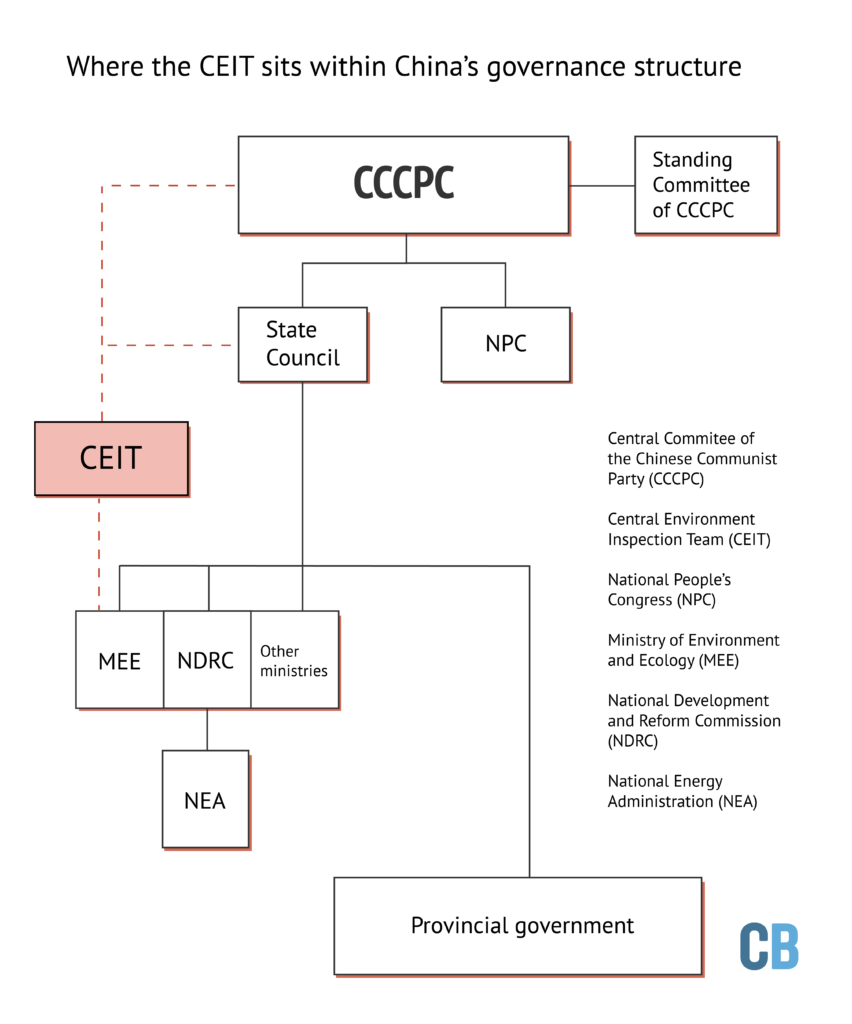
Why is the CEIT’s inspection of the NEA so significant?
The National Energy Administration (NEA) is a powerful ministry that is responsible for the approval, verification, supervision and regulation of all the nation’s energy-related assets. It is managed by the National Development and Reform Commission (NDRC), the core decision-maker on almost all of the important economic planning and systemic reforms.
Dr Yang Fuqiang, a senior adviser at the Beijing office of the Natural Resources Defence Council (NRDC), an environmental NGO, explains to Carbon Brief why this particular NEA inspection is “extremely significant”.
He says it aligns the NEA’s planning of the energy sector to China’s climate commitments, prior to the 14th “five-year plan” (14FYP), which strongly guides government policy for the 2021-2025 period and is due to be finalised and published next month. The energy sector currently accounts for about 70% of China’s greenhouse gas emissions and the inspection of the energy authorities can, therefore, have a significant impact on carbon emissions reduction.
Ma Jun adds that the NEA is at the center of China’s environmental governance, namely the “war on pollution” that President Xi declared in 2014 in response to the deteriorating environment and public health hazards. The NEA also impacts climate policy governance, due to its dominant decision-making power on the energy sector. He tells Carbon Brief:
“As a national bureau, the NEA was once among the inspectors from the central government that supervised others [provincial or municipal governments, or SOEs]. Now the ‘inspector’ becomes the ‘inspectee’. It is a significant change that the central government could also become a subject of inspection.”
Prof Daniel Gardner, a professor of history at Smith College in Massachusetts and a visiting research collaborator of the Princeton Environmental Institute, has been researching China’s “ecological civilisation”. He thinks the CEIT’s inspection on NEA “shouldn’t come as much of a surprise”, adding:
“As the country’s air pollution continues to be an urgent concern and climate change has taken global center stage, the country’s expansion of coal-fired power looks irresponsible, to say the least. Let alone very bad optics.”
How does the CEIT work?
Ma Jun says he has had a few working interactions with the CEIT and he was “very impressed”. The CEIT provides public “hotlines” and relies, in part, on tips from the public for its investigations. On the ground, an inspection team will “go deep” into villages and conduct investigations without the routine interference or accompaniment of local officials.
This is in stark contrast to the conventional working style of high-level inspections. In China, when higher level officials go to the local area to investigate, the local officials accompany them and can often lead the investigators away from the truth.
This, in turn, makes CEIT investigations quite arduous. “It’s very much like the work of an investigative journalist”, Ma Jun adds.
With the CEIT’s footprint rapidly spread across China, the CCCPC and MEE rely on the “environmental law enforcement units”, managed by the local “Office of Environment and Ecology” (which are overseen at provincial, municipal and county level by the MEE), to implement the inspection. Often, these local branches of MEE are understaffed and the CEIT has to mobilise civil servants from other government departments to participate in an inspection.
Ma Jun says emergency mobilisations could sometimes be made in the “middle of the night” without advance notice. “It’s like an emergency assembly of the army.”
He adds that when the CEIT presents evidence to local governments, the information is made public to “facilitate public scrutiny”.
Ma Jun’s Institute of Public & Environmental Affairs runs an information disclosure project called “Blue Map Big Data”, which records hundreds of thousands of pieces of information on pollution across the country. Ma Jun says that whenever the CEIT is active on the ground it always triggers a wave of “pollution record” submission from local citizens who want to document pollution incidents. He tells Carbon Brief:
“Prior to the visit of CEIT, many citizens had repeatedly filed complaints to local authorities on these polluting activities, but these complaints usually go nowhere. Now, CEIT reviews public complaints and tips regularly. [The intervention of CEIT] breaks the ‘protective umbrella’ on polluting enterprises from local governments.”
Dr Ran Ran, an associate professor of political science at Renmin University in Beijing, whose primary research focuses are environmental politics and environmental governance in China, tells Carbon Brief there was a major paradigm shift in environmental governance in China – from positive incentives to negative incentives – before and after the 18th National Congress of the CPC, reflecting the style and characteristics of the country’s new leadership.
The CPC’s 18th Congress was held in November 2012 and was when Xi Jinping’s leadership in China was confirmed. Dr Ran says:
“The CEIT was established to make sure that officials are fully aligned with the political priorities on environment protection. Beforehand, ‘environment performance’ was already written in the ‘political KPIs [key performance indicators]’ of local officials. However, even if environmental issues were not well handled and problems occurred, it did not necessarily have a clear consequence on their promotion. Now, if local officials fail to meet the environmental targets, they would expect a ‘punishment’ and be held accountable for noncompliance, to an extent that they could even risk their entire political career.”
Ma Jun considers the recent inspection on NEA an “improvement”, as it tackled the systemic issues at an institutional level. He says he had suggested to the CEIT to focus on “improving the mechanism”, in addition to investigating individual pollution cases. This is because the village-to-village investigation approach can be very resource-intensive and time-consuming.
However, Dr Ran expresses some doubts about the CEIT model:
“The top-down approach that the CEIT represents could indeed be very effective for tackling some of the environmental issues, as we have seen in the treatment of air pollution in Beijing in the last few years…But it has to combine with a bottom-up approach and welcome the participation of civil society in environmental governance.”
What does the CEIT’s accusation of a ‘deteriorated political ecology’ mean?
In its inspection of the NEA published last week, the CEIT said: “For some time, the political ecology of the NEA has deteriorated, which has also had a serious impact on the implementation of a relevant requirement for ecological protection.”
Dr Yang says that, in recent years, many high-profile NEA officials have been investigated for corruption – and this is what the accusation meant.
He adds: “Why did this round of inspectors choose the NEA in the first place? It is related to the continuous corruption.”
The latest NEA official to be arrested for corruption is Liu Baohua, its deputy director. Prior to this, two consecutive directors, Liu Tienan and Nur Bekri, were sentenced to life imprisonment for “severe” corruption.
Since 2008, more than 10 NEA officials have been convicted of corruption. Among them, the case of Wei Pengyuan, former deputy director of the NEA’s coal department, has attracted much attention. In 2014, law enforcement officers found 210m yuan (£24m) in cash in Wei Pengyuan’s home. To count the confiscated cash, four of the 16 currency counters from the law enforcement and the Central Commission for Discipline Inspection of CPC ended up being “burned out”.
Dr Lin Boqiang, director of the China Center for Energy Economics Research (CCEER) of Xiamen University, said in an interview last year with China Business News that the amount of investment in energy projects is huge – often amounting to billions of yuan. Power is concentrated with most projects approved by a small group of NEA officials meaning there is a lot of opportunity for corruption.
Daniel Gardner tells Carbon Brief:
“This [recent inspection] is a strong, unambiguous censure of the NEA, which leads me to wonder whether the stage is being set to reduce its authority or, perhaps, even to eliminate the agency altogether and move its administrative responsibilities elsewhere.”
What other accusations have been made against the NEA?
The CEIT found that the NEA failed to place environmental protection as a “high priority” in its planning and promoting of energy projects, which, the CEIT concluded, is the “main cause” of the “long-term extensive development” of China’s energy sector, namely the polluting coal industry.
The inspection report exposed several issues. For example, it said the NEA provided “insufficient guidance” on the planning and construction of coal power projects, and that it did not strictly control new coal power capacity in “key areas of air pollution, prevention and control” (“key area“). As a result, says the CEIT inspection report, “those that should be built are not being built and those that should not be built are built”. Overall, 12 provinces (cities) in the “key area” are still seeing increasing coal power plant capacity.
The “key areas” cover a wide range of geographies across China, namely megacity clusters with a high presence of industrial activities, such as Beijing, Tianjin, Hebei, the Pearl River Delta, the Yangtze River Delta, and some coal centres in Western China. Altogether, these “key areas”, consisting only 14% of the nation’s land area, accounted for more than half of China’s coal consumption and where the emission intensity was 2.9-3.6 times above the national average in 2010.
The report revealed that, from 2013 to 2017, the NEA gave planning approval for 22 coal-mining projects prior to receiving the review comments from their environmental impact assessments (EIA). Furthermore, 11 of the projects have not yet undergone any EIA.
According to the EIA law, any new construction projects that may cause even a minor environmental impact must carry out an EIA during the planning phase.
The report also criticised the NEA for not respecting the State Council’s “Action Plan for the Prevention and Control of Air Pollution” (“Action Plan“). Specifically, it did not prohibit the construction of “captive” coal-fired power plants in the “key areas”.
Rather than contributing to the “war on air pollution”, the NEA has been delaying the finalisation of a regulation on captive coal-fired power plants ever since NDRC released the “public consultation draft” in 2018.
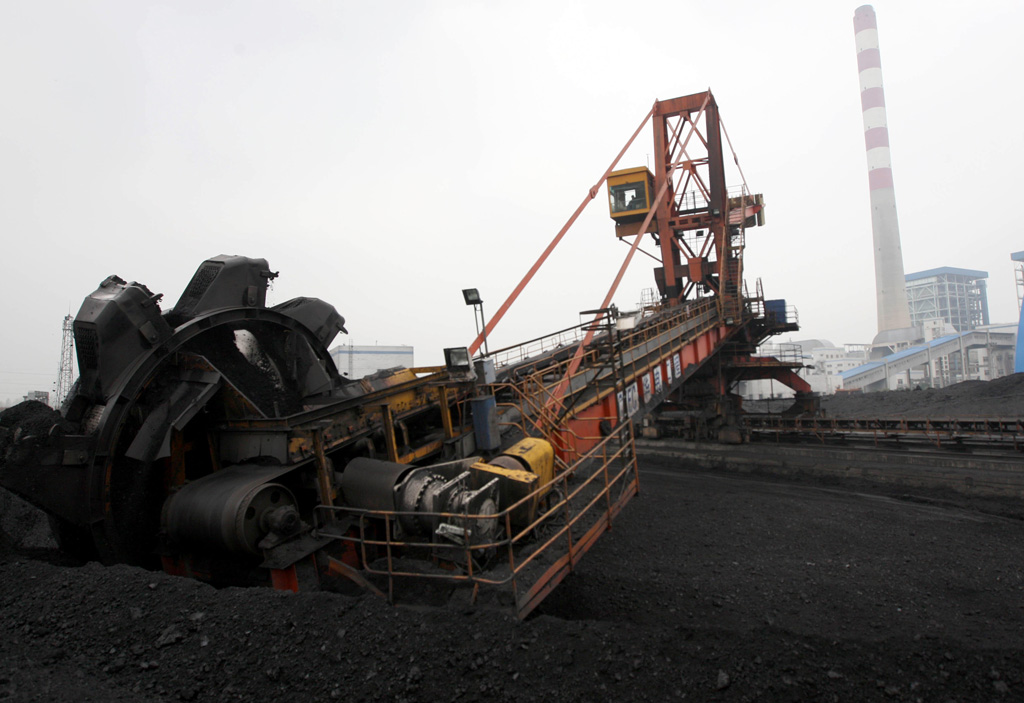
Captive coal-fired power plants are power plants set up by industrial companies to generate electricity for internal production use, rather than being connected to the grid. Energy-intensive industrial sectors, such as aluminium, iron, steel, chemicals and cement, are attempting to build their own captive coal-fired plants to secure stable power supplies and cut costs.
The new CEIT inspection report highlights that, in some key areas, new captive power plants are still under construction, which not only results in an overshoot of the government’s “coal consumption cap”, but also significantly aggravates local air pollution.
In addition, the CEIT highlighted the NEA’s “poor policy coordination” in resolving renewable curtailment (when renewable electricity ends up wasted due to system-wide oversupply or transmission constraints), among other issues. Specifically, two of China’s 14 “transmission corridors” delivered less than 1% of renewable energy.
Aiqun Yu from Global Energy Monitor (GEM) tells Carbon Brief that captive coal-fired power plants are much “dirtier” than the grid-connected ones. While newly constructed largescale coal-fired power plants are required to reach “supercritical” or “ultra-supercritical” levels, the regulation on captive power plants is very lax and many newly installed generation units remain at subcritical level – the dirtiest and most inefficient units on the market.
Supercritical and ultra-supercritical units are a popular “clean coal” technology in China. Their thermal efficiency can reach above 42% and 44-47%, respectively, compared to 38% of the subcritical units, leading to a reduction in carbon emission.
Despite the explicit ban from the “action plan”, many aluminium and chemical companies are still building more large scale captive coal power plants. According to GEM’s database, a total of 98 coal-fired generation units are under construction in the “key areas”, with a total planned capacity of 25GW.
In particular, one company alone, Shandong Weiqiao Aluminium and Power Company, has succeeded since 2012 in constructing new captive coal-fired power plants with a total of 17.5GW installed capacity in 2020.According to a new report jointly published by GEM and Centre for Research on Energy and Clean Air (CREA), by comparison, only 11.9GW of new coal-fired power plants have currently been commissioned across the rest of the world.
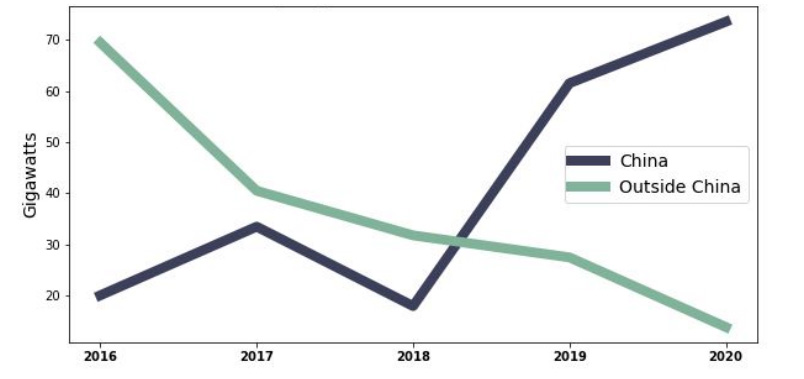
Aiqun Yu says the NEA often uses the variability of renewable energy as an excuse to plan more coal power plants, saying they “back up” renewable generation and ensure grid stability.
What comes next now that the CEIT’s criticisms have been made public?
The CEIT requires the NEA to urgently “study and formulate a rectification plan” and submit it to the CCCPC and the State Council within 30 working days.
Ma Jun hopes the NEA can tackle all the problems identified by CEIT. But he has some doubts about long-term planning. He tells Carbon Brief:
“What will happen to the ‘unplanned, but constructed’ coal power plants, and to those ‘planned, but not constructed’ plants? Will they still be under the context of China’s new climate targets on carbon neutrality? If the ‘coal bases’ in western China continue to expand, carbon emissions will continue to increase and it could lead to financial risks.”
Dr Yang believes that the NEA’s “rectification” report to the CCCPC and MEE may not be made public until after the “Two Sessions” next month. “Two Sessions” refer to the annual gathering of the National People’s Congress (NPC) and the Chinese People’s Political Consultative Conference (CPPCC), during which the 14th five-year plan will be discussed, voted on, approved and officially released.
Dr Gardner thinks the inspection report on the NEA could be an indication that the leadership in Beijing may side with environmental concerns in the upcoming five-year plan period (2021-2025) and is prepared to “begin the drawdown of coal capacity immediately”. He adds:
“It’s no secret that proponents of China’s energy independence and security have been urging leaders to raise the ceiling of the country’s coal capacity. However, it is not easy to see how China’s leaders could agree to this sort of expansion in fossil fuel production and consumption in light of its recent climate pledges.”
Will any ‘rectifications’ made by the NEA impact China’s climate and energy policies?
The CEIT’s report concludes that the NEA’s major problem is treating the “securing of energy supply” as the top priority of the energy sector at the expense of the environment. Dr Gardner tells Carbon Brief:
“Whether the NEA is just a ‘fall guy’ here, or generally deserves the bulk of the blame, the CEIT’s report is sending a loud message – domestically and internationally – that the central government now means to play a more aggressive and direct role in reining in the construction of coal plants.”
He adds that the messages are not just intended for authorities at the NEA, but also for local officials “who have stimulated their economies by investing in the country’s traditional carbon-intensive industries”. He continues:
“It’s a cautionary signal to local authorities that, if the NEA can’t exercise effective control over the actions of these authorities, the party and central government are prepared to step in and make structural changes. The central government wants local authorities to take heed: it’s time to play by the central government’s stated environmental aspirations.”
Gardner also thinks it is a “harsh rebuke” by publicly criticising the NEA for not effectively promoting the principles of “Xi Jinping’s thought on ecological civilisation”.

Yang Fuqiang also thinks “institutional changes” should be made to the NEA. He suggests expanding the NEA’s functions to include “dealing with climate change” and “saving energy”, by setting up a dedicated department within its existing structure.
However, Gardner thinks it would be better for the governance reform to take place at the MEE, which is already responsible for environmental protection and compliance with international conventions, such as the UN’s Paris Agreement. He expects to see the MEE given greater human and financial resources, plus stronger administrative authority.
Dr Ran says it is unlikely China will set up a separate government department or agency to deal with climate change. She adds that making the MEE a “super ministry” that also oversees energy-related planning would be impractical and could face strong resistance from NDRC, among other ministries.
She also tells Carbon Brief that energy-related planning is already being made by the NDRC, which is “senior” to the NEA and has long been responsible for climate-related issues – from representing China at the UN climate negotiations to planning the National Climate Change Program. Before the CCCPC came to work with the MEE to institutionalise the CEIT in 2019, NDRC’s climate-related responsibilities had already been transferred to the MEE under a government overhaul in 2018. Dr Ran says:
“The direct leadership from CCCPC in the CEIT may help to coordinate the conflicts within the bureaucracy, but it doesn’t mean the conflicts have disappeared.”
What has the wider reaction been?
The CEIT’s inspection report immediately sparked strong reactions outside China, with some observers calling it “a highly encouraging development” and “groundbreaking”.
Some observers of China’s energy and climate policy have interpreted it as a signal of the CCCPC and State Council’s intention to accelerate its energy transition, namely, phasing out coal power plants and scaling up renewable energy installation and integration.
Inside China, however, the media responded with near silence, with hardly any Chinese media picking up the story. Very few have produced further analysis beyond reciting or summarising the text of the inspection report.
Eknower, a popular Chinese online publication focused on the energy industry, is an exception. It says that the CEIT report “clearly outlined” the energy infrastructure that will be developed in the 14th five-year plan period (2021-2025).
It concludes that the environment must be safeguarded within any energy development and that this be as equally important as securing energy security. The article predicts that many of the “approved, but not yet constructed” coal power plants will be cancelled and a wave of “clear-up actions” are expected to regulate the captive coal power plants.
However, in contrast to the prediction made by Eknower and some international observers, Ma Jun warns about the misinterpretation of the inspection report. He tells Carbon Brief:
“The CEIT seeks to hold the NEA accountable for its non-competence regarding past work. It is unlikely that the CEIT initiated the inspection as a result of the newly announced climate targets on peak emissions and carbon neutrality. That said, the energy plan is indeed a climate issue. It’s up to the NEA to learn from past lessons and not to repeat the same mistakes when dealing with [future] climate action work plans [from the central government]”.
On 3 February, the NEA released a brief communication on a special meeting organised on 29 January, the same day when the CEIT released the inspection report. All of the NEA’s top leadership attended the meeting, during which a work plan on rectification – “a current major political task” – is discussed with a “special work unit” being formed.
The NEA says that it will take the “most immediate actions” and “most effective measures” with the “most resolute attitude”, to promote the “harmonious development” of energy and the environment to a new level.
It’s a “comprehensive and profound political check-up”, the communication adds.
-
Q&A: Could an environmental inspector’s criticisms accelerate China’s climate policies?


